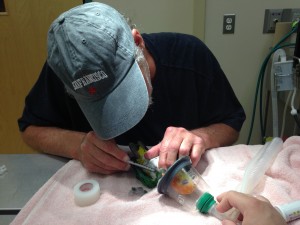An animal’s blood contains an incredible amount of information if you know how to look. You can find signs of infection, or signs of an infection that occurred in the past. You can discover whether an animal has had enough to eat, if it is missing a specific type of vitamin or mineral, or if it has had too much of the same. These are among the vast array of conditions that can be effectively diagnosed by examining an animals blood. Most of the more complicated tests are very expensive and require specialized machinery and testing supplies. In order to make the process more efficient, most veterinarians send out their blood samples to a lab that specializes in these tests and that can quickly and efficiently get all the pertinent results.
There are a few specific tests that we like to do in-house however, for a good first impression of some of the more critical aspects of an animals health. This helps us assess their state as stable or critical, and can make it easier to create an accurate and effective treatment plan. The four values we tend to look at for almost every animal are blood glucose, total protein, hematocrit, and buffy coat.
While not as exhaustive as the more complicated tests, these tend to give a basic picture of an animal’s state of health. Blood glucose is a general way of measuring how much nourishment an animal has received in the recent past. If they have had steady meals for a day or two before the test then the levels should be normal. If low, it implies the animal has not gotten enough food recently, and if high it implies the animal is stressed. Total protein is a measure that we use in a similar fashion, although not quite the same. If the total protein is low then it is likely that the animal has been deprived of nutrition for an extended period of time and is malnourished. High total protein levels on the other hand indicate the presence of inflammation, and makes it likely that there is an infection present.
Hematocrit refers to the percentage of actual red blood cells in relation to the amount of plasma, mostly water, that makes up what we see as blood. There is generally a larger amount of water than actual red blood cells, but if there is even more plasma than normal (a low hematocrit value) then it implies that the animal is having trouble producing blood cells or they are being destroyed by something. This can be due to a variety of factors, including lead poisoning and hematoparasites. A high hematocrit value means that there is not enough water in the blood, and suggests that the animal is dehydrated. Finally, the buffy coat can be roughly described as an indicator of the amount of white blood cells present at the time the blood was drawn. A higher than normal value for this means that there could be an infection.
These are all general values, and while they are useful to observe they cannot conclusively identify an issue without other symptoms being taken into account or more exhaustive testing done. They are easy to get for most animals we get in however, and can be very useful for identifying a large number of common problems.


